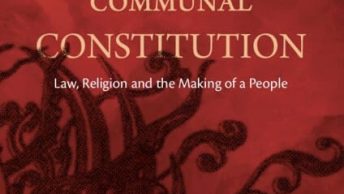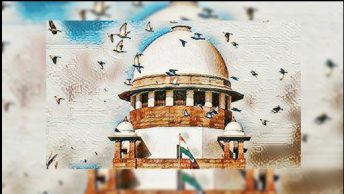Summary: In this piece, we continue the discussion on Prof. Nivedita Menon’s latest book, Secularism as Misdirection: Critical Thought from the Global South. The summary of the book by Prof. Menon can be accessed here. Its review by Prof. Kalpana Kannabiran can be accessed here, by Prof. Aditya Nigam can be accessed here, and by Prof. Hilal Ahmed can be accessed here. In this piece, Prof. Sasanka Perera provides his comments on the introductory chapter of the book.
Nivedita Menon’s book, Secularism as Misdirection, is not merely an intellectual exercise in dissecting some outstanding but often overlooked issues in the debates on secularism. Particularly the introduction is also in itself a kind of ‘textbook’ that deals with what terms such as ‘secularism’ and ‘global South’ actually mean in discursive contexts, where these terms are simultaneously known and patently unknown.
Pedagogy and Working Across Traditions
I am sure those of us who have taught or are teaching in universities know quite well that at times, colleagues and students alike tend to be flippant in the way they deploy concepts and categories, including ‘secularism’ and ‘global South’ among many others. To me, this reflects what social sciences and humanities have become in our institutions. This creates a sense of conceptual uncertainty and anxiety when it comes to pedagogy. I consider pedagogy to be far more important in intellection than the seemingly theoretical, obscure and abstract writings we must deal with as a quotidian academic matter, that are often unrelated to location, experience and history.
Nivedita’s book achieves this pedagogical prerogative right from the beginning while also adding considerably to the discourse on secularism with a pronounced sense of nuance and reflection. Her attempt is not only relevant to India or South Asia, but elsewhere too where there is an interest in working across traditions and in decolonizing theory, philosophy and the broader domains of social sciences and humanities.
For her, the global South does not mean a “geographical region” or a “category within a developmental discourse” (pg 2-3). Instead, it is a “space of thought, the possibility of revaluing and learning from speech that exists in the margins, of reworking the co-ordinates of intellectual labour to free ourselves from Eurocentric universalizing narratives, and to destabilise the East–West distinction which is routinely made in the context of thought and intellection” (pg 2-3). This conception of the global South might seem self-evident. However, in the years I co-taught the PhD course, ‘Social Theory, Society and Modes of Thinking’ with Ravi Kumar at South Asian University, the global South often manifested in multiple renditions in class, most commonly as a disconnected geographic region, scarred by colonialism and lacking in development — the so-called ‘Third World’ of the Cold War American State Department lexicon. This was despite it being a course that deliberately attempted to work across traditions and theorize from the global South and encouraged students to be wary of what Nivedita has called, ‘Eurocentric universalizing narratives.’ The situation was not too different in other teaching and discursive spaces I was associated with.
Given this general situation, from a pedagogical point of view, Nivedita’s effort in the first chapter involves mooring the concept’s meaning to something concrete that simultaneously resonates with the idea of working across traditions.
But again, in a pedagogic sense, what does ‘working across traditions’ actually mean? For Nivedita, this refers to “thinking the global South” which should “bring into conversation with one another concepts and categories that have emerged from different spatio-temporal locations” (pg 4). Crucially, this conversation ideally must be “produced with the sharp awareness of incommensurability, mistranslation, productive misreading, and above all, and always, the awareness of the materiality and politics of location” (pg 4).
It is precisely what Nivedita has referred to here as an idea that Ravi Kumar and I tried to do in our course with different degrees of success and failure, depending on how invested students were in engaging with these ideas. In essence, redesigning what used to be called ‘Advanced Sociological Theory’ to what we called ‘Social Theory, Society and Modes of Thinking’ was an attempt to encourage our students to think about stepping beyond Eurocentric universalizing bodies of theory and philosophy to experiment with ways to think from the global South, South Asia and India, in that order, within and outside the classroom.
That is, it was an attempt to privilege our location, history and contemporary politics via a route that took us on a journey across time and space by way of the ideas of B.R. Ambedkar, Walpola Rahula, Bhagat Singh, Mohandas Gandhi, Jyotirao Phule, Erode Venkatappa Ramasamy, better known as Periyar, and abstract notions from Buddhist philosophy focused on ideas like the self, liberation, and knowledge among others. It also brought in personal experiences and specific locations in society and times along with the works of poets such as Faiz Ahmed Faiz and Nazrul Islam to bear upon the process of understanding the region and theorizing from there and about the region. Our interest was also to see how these efforts might help in reading the world beyond. However, this was attempted while being mindful of the locations, experiences and histories that provided the genesis for this approach in the first place. What we were aiming for and concerned about in this exercise has been much better articulated by Nivedita in the following words (pg 2):
“A limitation of any comparative theorising exercise across cultural and geographical contexts—especially with the goal of better understanding one’s own location—is that the selective study of “other” locations might make the latter seem under-theorised, and under-contextualised in terms of their own dense debates. This is, all the same, a better mode of theorising than simply applying theory—on the assumption of its universality— from the North to other parts of the globe, this having long become a normalised and largely unquestioned mode.”
The dominant forms of allegedly ‘universal’ knowledge have come to us via the western colonization project in our region, the mostly non-reflective embracing of Enlightenment knowledge and the colonized and unimaginative post-colonial thinking that still hold sway. Some of these questions were raised very eloquently by Banerjee et.al in their 2016 essay ‘The Work of Theory: Thinking Across Traditions.’ Unfortunately, this trend has become normalized largely due to the unquestioned and non-reflective acceptance of such knowledge by many, nudging me to often ponder if the title of Kishore Mahbubani’s 1998 book, Can Asians Think? (2002) has merit beyond that book.
Similarly, Renny Thomas’ and my effort in putting together our forthcoming book on South Asian keywords and attitudes is also an attempt to work across traditions and theorize from the global South. Particularly via South Asian languages from Hindi to Hebrew-Malayalam and from Assamese to Sinhala, we took a look at selected analytical and descriptive categories of these languages, compounded by their histories, locations and contexts to explore if it might be possible to make these words and categories speak to thinkers beyond these linguistic communities who are working in broader domains of social sciences and humanities. Our aim was to nudge interested people in the direction of decolonizing social sciences and humanities in the region.
I bring up these two examples in this discussion for a reason. In my mind, both these attempts were about – as Nivedita puts it – “an insistence on privileging location, a recognition that spatial and temporal co-ordinates inevitably suffuse all theorizing,” (pg 3) which also meant that “a sensitivity to location invariably leads to a productive contamination of the purity of empty universalist categories with specific histories, thus challenging their claim to speak about everywhere from nowhere, pointing towards unexpected other histories that unsettle the idea of a single point of origin” (pg 3). In other words, if Nivedita’s effort is a roadmap to understanding the global South, thinking from there, finding ways to work across traditions and make visible what has been rendered invisible in the debates on secularism, ours was a minor but pragmatic effort in actually implementing some of these ideas on the ground.
Secularism and its Misdirections
Nivedita’s main effort of course is to unpack the notion of secularism. She self-reflectively explores secularism via the prisms of religion, caste, race, citizenship, gender, psychoanalysis, capitalism and ecology.
I have always had reservations about the way secularism, a notion originally derived from Christian thought in the 1500s, has been deployed in South Asia in general but specifically in India and Sri Lanka. I am intrigued by Nivedita’s deployment of the metaphors of ‘smoke’ and ‘mirrors’ that makes some aspects of what she calls the “magic term ‘secularism’” become invisible while others become hypervisible (pg 28-34). But this emotional-political-intellectual smoke screen is not unique to the way debates on secularism have been handled and sometimes mishandled. The same has occurred in the way scholars have tried to look at concepts that range from cosmopolitanism to federalism to terrorism to fundamentalism. In all cases, contextual limitations in these ideas have emanated due to their use ahistorically, plucking them recklessly from specific locations with specific histories and contexts and imposing them on other locations – such as on India, South Asia or elsewhere in the global South – that have no direct association with the conditions that gave genesis to these concepts. This practice is linked to our widespread and uncritical assumption of the universality of western theory and philosophy, an issue with which Nivedita also deals.
At one level, as Nivedita points out, debates on secularism assumed the existence of “a specific field, separate from politics and the state, recognizable as religion” (pg 28-29) and that “modern politics is manifested in establishing a wall between the two” (pg 28-29). It is this wall that allows for this understanding of secularism to exist. This reductionist understanding of secularism does not do justice to comprehend how the multiple meanings of secularism might actually exist on the ground in our historico-cultural locations. It also renders invisible other thematics and social factors that Nivedita refers to by making selected issues hypervisible.
The understanding of secularism in India as ‘sarva dharma sama bhava’ — the equality of all religions — is a far more reasonable notion that offers a glimpse into the complexity of what secularism can entail including democratic practices, as opposed to its Sinhala renditions, ‘ayihikawaadaya’ or ‘lokayanthawaadaya’ both of which link the notion too narrowly and simply to matters of the material world. It is this latter understanding of secularism that makes the non-secular, non-individuated, non-rational self-invisible (pg 30-31), thereby making any attempt to understand society within this context incomplete. Nivedita’s attempt to unravel this in the fourth chapter, for me, is the most instructive segment in her book.
Despite what the title may suggest to people who have not read Nivedita’s book, her attempt is not to abandon secularism due to the debates that make some crucial issues linked to democracy invisible. Instead, she argues convincingly to comprehend its complexity and convey the need to understand it with nuance rather than through rhetoric. As she observes, “… secularism is not in itself a positive value and nor is its meaning self-evident. Secularism can serve majoritarian, anti-minority politics, and capitalist transformation, but it can equally be invoked to sustain democratic politics that respects heterogeneity, social justice, and ecological concerns” (pg 33).
Sasanka Perera is Chairman at Colombo Institute for Human Sciences, Sri Lanka and was Professor of Sociology at University of Colombo and later at South Asian University prior to his retirement in August 2024. He was the founding Editor of Society and Culture in South Asia and is the author of ‘The Fear of the Visual? Photography, Anthropology, and Anxieties of Seeing’ (2020). He has researched on the thematic issues of contemporary visual art in Sri Lanka, violence and memory, religion and politics.






Websitesi Satın al
Rolex Saatler
Rolex Saatler
İmitasyon Saatler
Rolex Saatler
Rolex Saatler
Rolex Saatler
Rolex Saatler
Rolex Saatler
İmitasyon Saatler
İmitasyon Saatler
İmitasyon Saatler
Rolex Saatler
İmitasyon Saatler
İmitasyon Saatler
Websitesi Satın al
I do believe all the ideas youve presented for your post They are really convincing and will certainly work Nonetheless the posts are too short for novices May just you please lengthen them a little from subsequent time Thanks for the post
İmitasyon Saatler
İmitasyon Saatler
Rolex Saatler
İmitasyon Saatler
Rolex Saatler
İmitasyon Saatler
İmitasyon Saatler
Rolex Saatler
İmitasyon Saatler
Rolex Saatler
İmitasyon Saatler
Rolex Saatler
İmitasyon Saatler
Rolex Saatler
Rolex Saatler
Rolex Saatler
İmitasyon Saatler
Rolex Saatler
İmitasyon Saatler
Rolex Saatler
Rolex Saatler
Rolex Saatler
Rolex Saatler
İmitasyon Saatler
İmitasyon Saatler
Rolex Saatler
Rolex Saatler
Rolex Saatler
İmitasyon Saatler
Rolex Saatler
Rolex Saatler